线程池使用及优势
线程池做的工作主要是控制运行的线程的数量,处理过程中将任务放入队列,然后在线程创建后启动这些任务,如果线程数量超过了最大数量超出数量的线程排队等候,等其他线程执行完毕,再从队列中取出任务来执行。
主要特点
线程复用;控制最大并发数;管理线程。
- 第一:降低资源消耗。通过重复利用已创建的线程降低线程创建和销毁造成的消耗。
- 第二,提高响应速度。当任务到达时,任务可以不需要的等到线程创建就能立即执行。
- 第三,提高线程的可管理性。线程是稀缺资源,如果无限制的创建,不仅会消耗系统资源,还会降低系统的稳定性,使用线程池可以进行统一的分配,调优和监控。
线程池如何使用?
架构说明
Java中的线程池是通过Executor框架实现的,该框架中用到了Executor,Executors,ExecutorService,ThreadPoolExecutor这几个类。
线程池的底层就是ThreadPoolExecutor
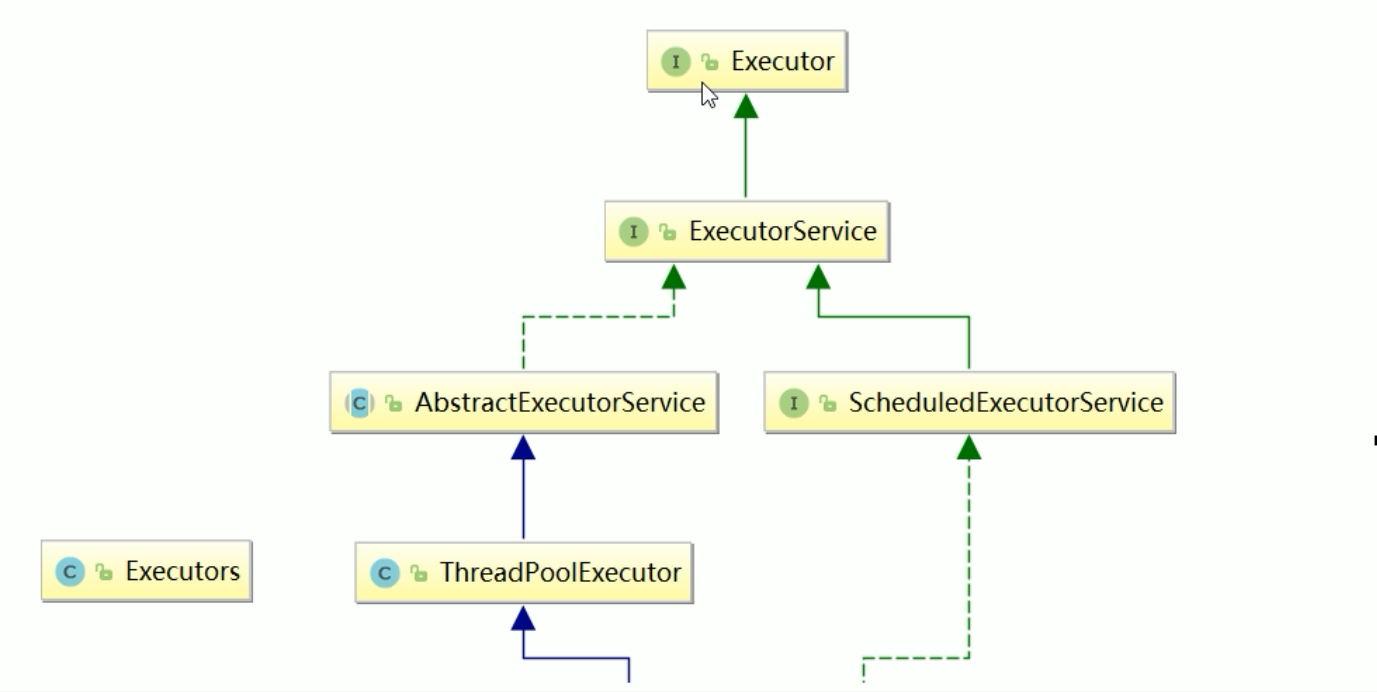
线程池3个常用方式
newFixedThreadPool
package com.threadTest;
import java.util.concurrent.ExecutorService;
import java.util.concurrent.Executors;
/**
* 线程池
* 第四种获得/使用java多线程的方式, 前三种分别是 继承Thread类,实现Runnable接口,实现callable接口(有返回值有异常)
*
*/
public class MyThreadPoolDemo {
public static void main(String[] args) {
//一池5个处理线程
ExecutorService threadPool = Executors.newFixedThreadPool(5);
//模拟10个用户来办理业务,每个用户就是一个来自外部的请求线程
try {
for (int i = 1; i <= 10; i++) {
threadPool.execute(() -> {
System.out.println(Thread.currentThread().getName()+"t 办理业务");
});
}
} catch (Exception e) {
e.printStackTrace();
}finally {
threadPool.shutdown();
}
}
}
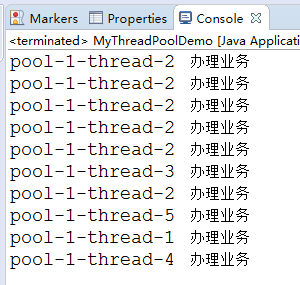
newSingleThreadExecutor
package com.threadTest;
import java.util.concurrent.ExecutorService;
import java.util.concurrent.Executors;
/**
* 线程池
* 第四种获得/使用java多线程的方式, 前三种分别是 继承Thread类,实现Runnable接口,实现callable接口(有返回值有异常)
*
*/
public class MyThreadPoolDemo {
public static void main(String[] args) {
//一池1个处理线程
ExecutorService threadPool = Executors.newSingleThreadExecutor();
//模拟10个用户来办理业务,每个用户就是一个来自外部的请求线程
try {
for (int i = 1; i <= 10; i++) {
threadPool.execute(() -> {
System.out.println(Thread.currentThread().getName()+"t 办理业务");
});
}
} catch (Exception e) {
e.printStackTrace();
}finally {
threadPool.shutdown();
}
}
}
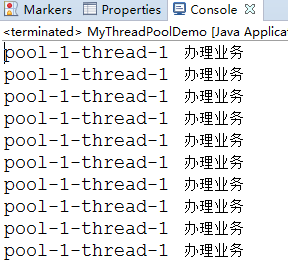
newCachedThreadPool
package com.threadTest;
import java.util.concurrent.ExecutorService;
import java.util.concurrent.Executors;
/**
* 线程池
* 第四种获得/使用java多线程的方式, 前三种分别是 继承Thread类,实现Runnable接口,实现callable接口(有返回值有异常)
*
*/
public class MyThreadPoolDemo {
public static void main(String[] args) {
//一池N个处理线程
ExecutorService threadPool = Executors.newCachedThreadPool();
//模拟10个用户来办理业务,每个用户就是一个来自外部的请求线程
try {
for (int i = 1; i <= 10; i++) {
threadPool.execute(() -> {
System.out.println(Thread.currentThread().getName()+"t 办理业务");
});
}
} catch (Exception e) {
e.printStackTrace();
}finally {
threadPool.shutdown();
}
}
}
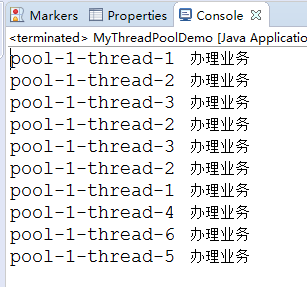
但是如果每次停0.2秒呢?
package com.threadTest;
import java.util.concurrent.ExecutorService;
import java.util.concurrent.Executors;
import java.util.concurrent.TimeUnit;
/**
* 线程池
* 第四种获得/使用java多线程的方式, 前三种分别是 继承Thread类,实现Runnable接口,实现callable接口(有返回值有异常)
*
*/
public class MyThreadPoolDemo {
public static void main(String[] args) {
//一池N个处理线程
ExecutorService threadPool = Executors.newCachedThreadPool();
//模拟10个用户来办理业务,每个用户就是一个来自外部的请求线程
try {
for (int i = 1; i <= 10; i++) {
threadPool.execute(() -> {
System.out.println(Thread.currentThread().getName()+"t 办理业务");
});
//暂停200毫秒
try {TimeUnit.MILLISECONDS.sleep(200);}catch(InterruptedException e) {e.printStackTrace();}
}
} catch (Exception e) {
e.printStackTrace();
}finally {
threadPool.shutdown();
}
}
}
说明应付得过来就不需要那么多线程,这个机制是灵活处理。
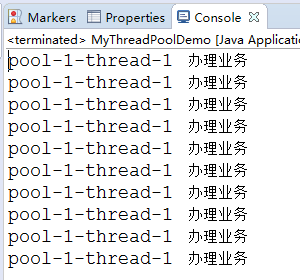
底层是什么?
底层都是ThreadPoolExecutor
newFixedThreadPool
- 1.创建一个定长线程池,可以控制线程最大并发数,超出的线程会在队列中等待
- 2.newFixedThreadPool创建的线程池corePoolSize和maximumPoolSize值时相等的,它使用的LinkedBlockingQueue;
public static ExecutorService newFixedThreadPool(int nThreads) {
return new ThreadPoolExecutor(nThreads, nThreads,
0L, TimeUnit.MILLISECONDS,
new LinkedBlockingQueue<Runnable>());
}
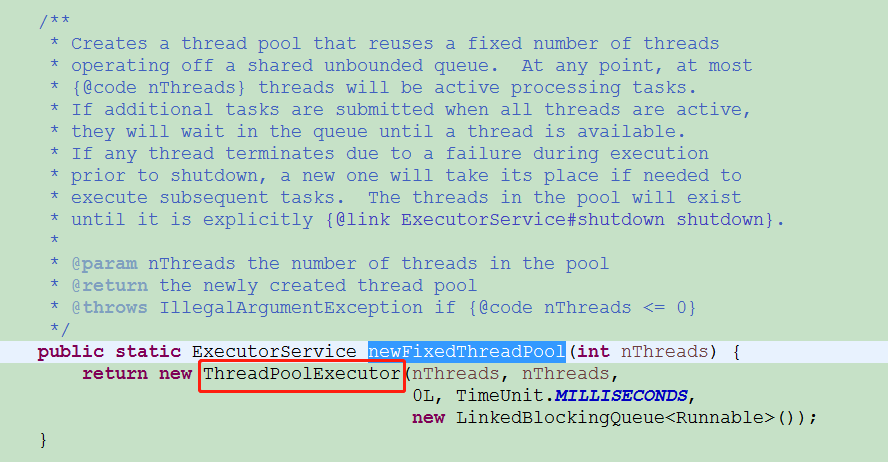
newSingleThreadExecutor
- 1.创建一个单线程化的线程池,它只会用唯一的工作线程来执行任务,保证所有任务按照指定顺序执行。
- 2.newSingleThreadExecutor将corePoolSize和maximumPoolSize都设置为1,它使用的LinkedBlockingQueue;
public static ExecutorService newSingleThreadExecutor() {
return new FinalizableDelegatedExecutorService
(new ThreadPoolExecutor(1, 1,
0L, TimeUnit.MILLISECONDS,
new LinkedBlockingQueue<Runnable>()));
}
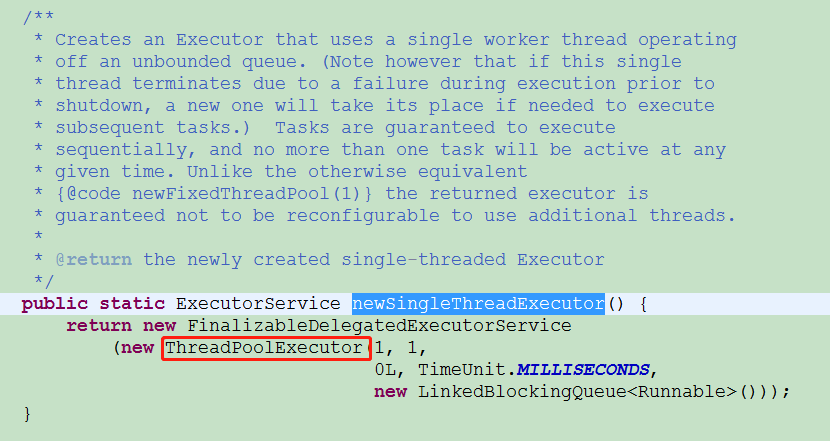
newCachedThreadPool
- 1.创建一个可缓存线程池,如果线程池长度超过处理需要,可灵活回收空闲线程,若无可回收,则新建线程。
- 2.newCachedThreadPool将corePoolSize设置为0,将maximumPoolSize设置为Integer.MAX_VALUE,使用的SynchronousQueue,也就是说来了任务就创建线程运行,当线程空闲超过60秒,就销毁线程。
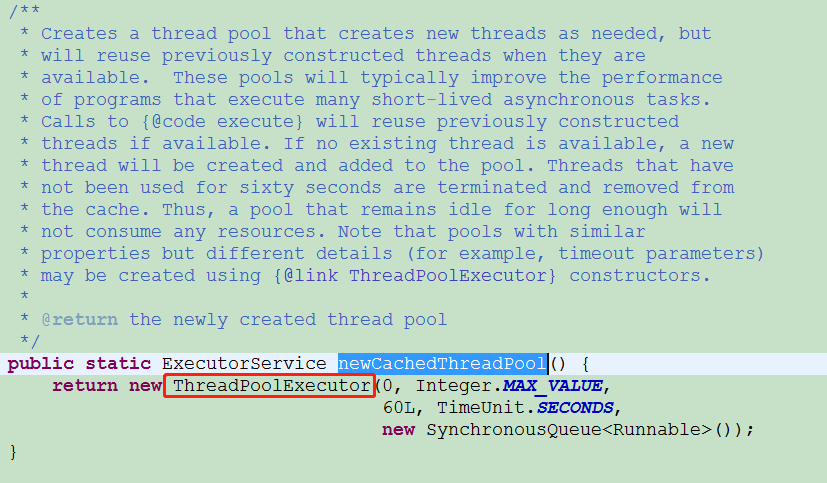
线程池7大参数入门简介
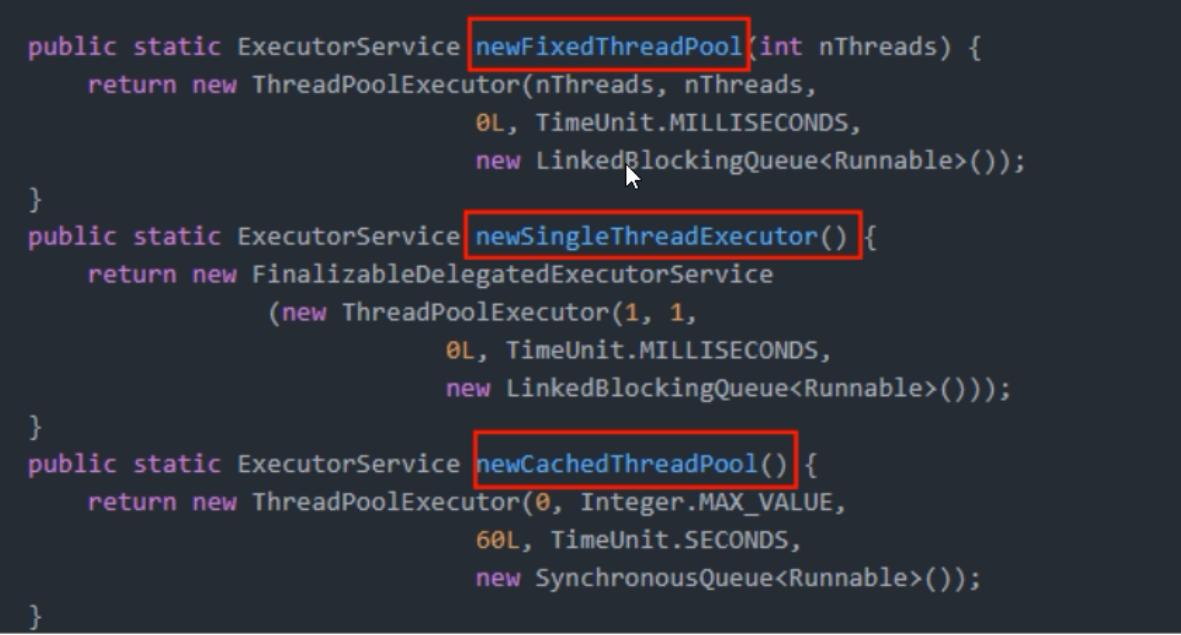
ThreadPoolExecutor底层有七个参数

- 1.corePoolSize: 线程池中的常驻核心数
在创建了线程池后,当有请求任务来之后,就会安排池中的线程去执行请求任务,近似理解为今日当值线程。
当线程池中的线程数目达到corePoolSize后,就会把到达的任务放到缓存队列当中。
- 2.maximumPoolSize: 线程池能够容纳同时执行的最大线程数,此值必须大于等于1
- 3.keepAliveTime: 多余的空闲线程的存活时间。
当前线程池数量超过corePoolSize时,当空闲时间达到keepAliveTime值时,多余空闲线程会被销毁直到只剩下corePoolSize个线程为止 - 4.unit: keepAliveTime的单位。
- 5.workQueue: 任务队列,被提交但尚未被执行的任务。
- 6.threadFactory: 表示生成线程池中工作线程的线程工厂,用于创建线程一般用默认的即可。
- 7.handler: 拒绝策略,表示当队列满了并且工作线程大于等于线程池的最大线程数(maximumPoolSize)。
小例子:
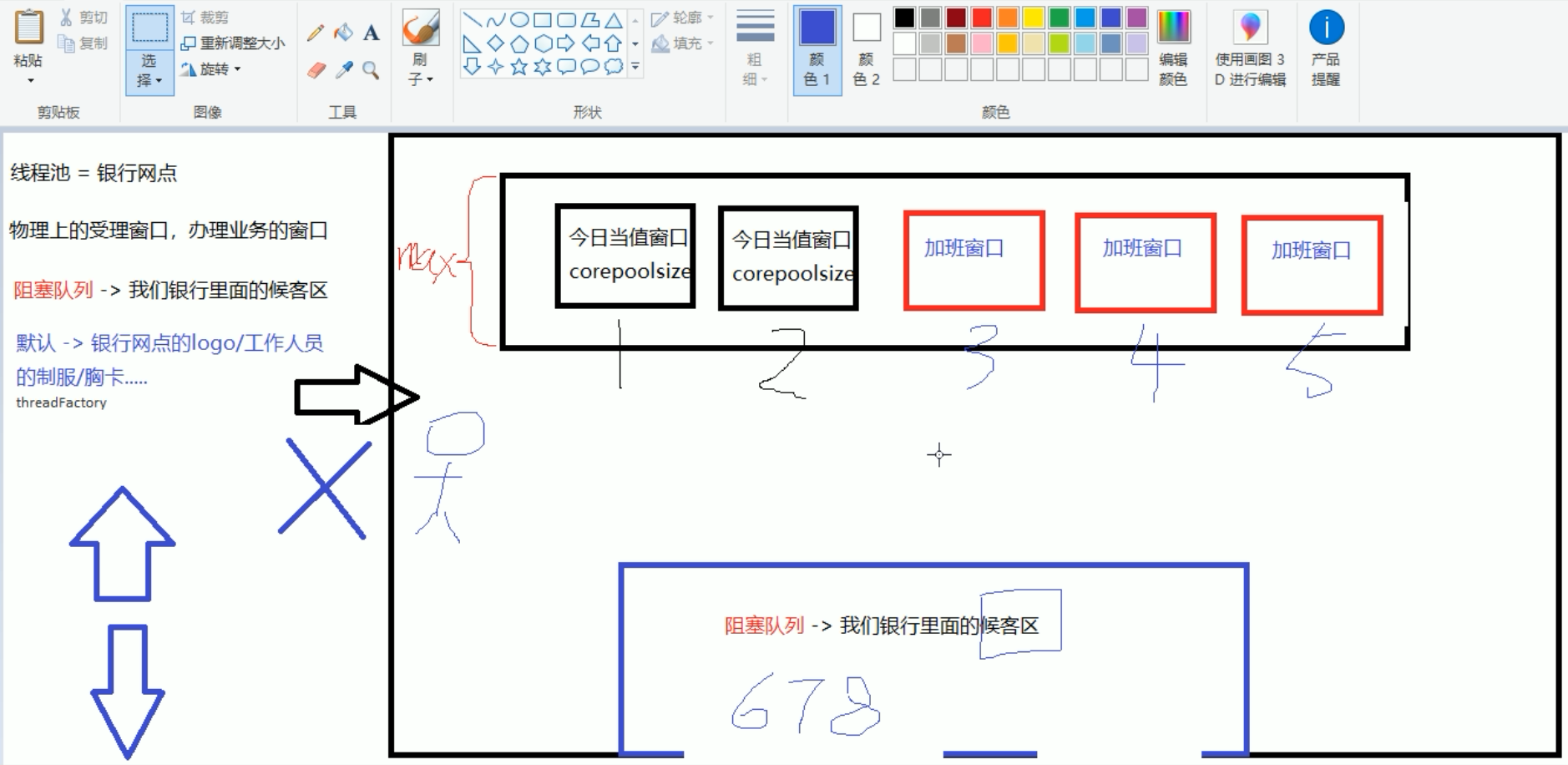
线程池的底层工作原理
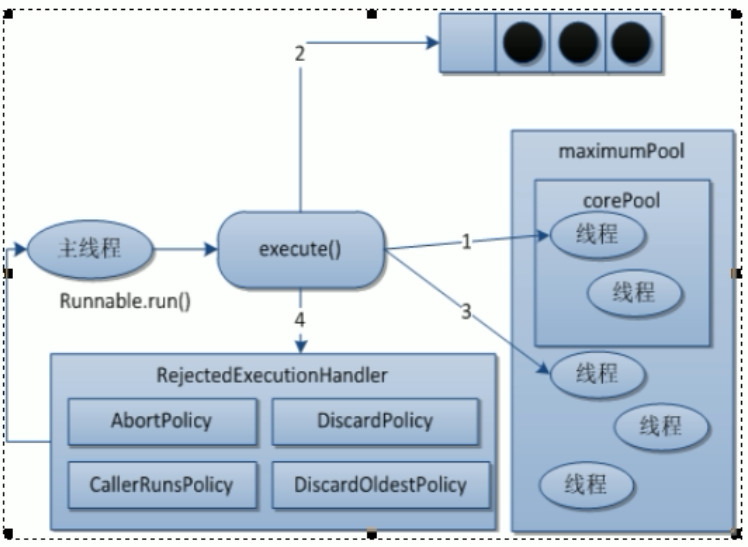
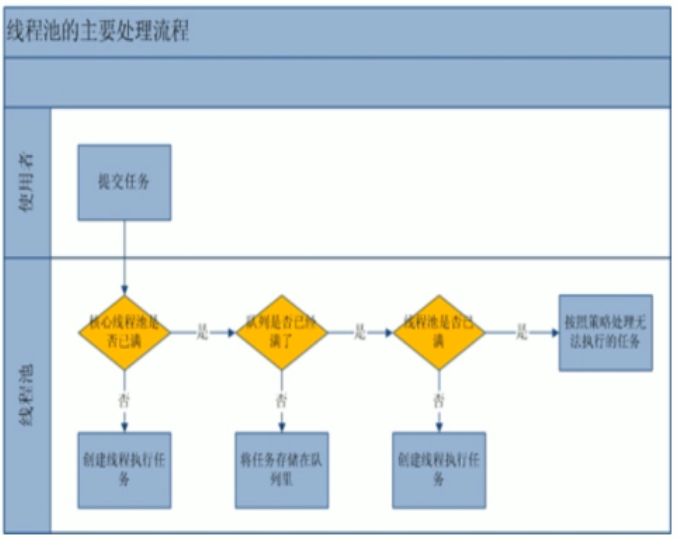
- 在创建了线程池后,等待提交过来的任务请求。
- 当调用execute()方法添加一个请求任务时,线程池会做如下判断:
2.1 如果正在运行的线程数量小于corePoolSize,那么马上创建线程运行这个任务;
2.2 如果正在运行的线程数量大于或等于corePoolSize,那么将这个任务放入队列;
2.3 如果这个时候队列满了且正在运行的线程数量还小于maximumPoolSize,那么还是要创建非核心线程立刻运行这个任务;
2.4 如果队列满了且正在运行的线程数量大于或等于maximumPoolSize,那么线程池会启动饱和拒绝策略来执行。 - 当一个线程完成任务时,它会从队列中取下一个任务来执行。
- 当一个线程无事可做超过一定的时间(keepAliveTime)时,线程池会判断:
如果当前运行的线程数大于corePoolSize,那么这个线程就被停掉。
所以线程池的所有任务完成后它最终会收缩到corePoolSize的大小。
线程池的4种拒绝策略理论简介
是什么?
等待队列也已经排满了, 再也塞不下新任务了。
同时,线程池的max线程也达到了,无法继续为新任务服务。
这时候我们就需要拒绝策略机制合理的处理这个问题。
JDK内置的拒绝策略
AbortPolocy(默认)
直接抛出RejectedExecutionException异常阻止系统正常
CallerRunsPolocy
"调用者运行"一种调节机制,该策略既不会抛弃任务,也不会抛出异常,而是将某些任务回退到调用者,从而降低新的任务流量。
DiscardOldestPolicy
抛弃队列中等待最久的任务,然后把当前任务加入队列中尝试再次提交当前任务
DiscardPolicy
直接丢弃任务,不予任何处理也不抛出异常。如果允许任务丢失,这是最好的一种方案。
工作中用哪个
答案是一个都不用,我们生产上只能使用自定义的Executors中JDK已经给你提供了 。
为什么不用?要自己手写
我们来看看阿里巴巴手册怎么说
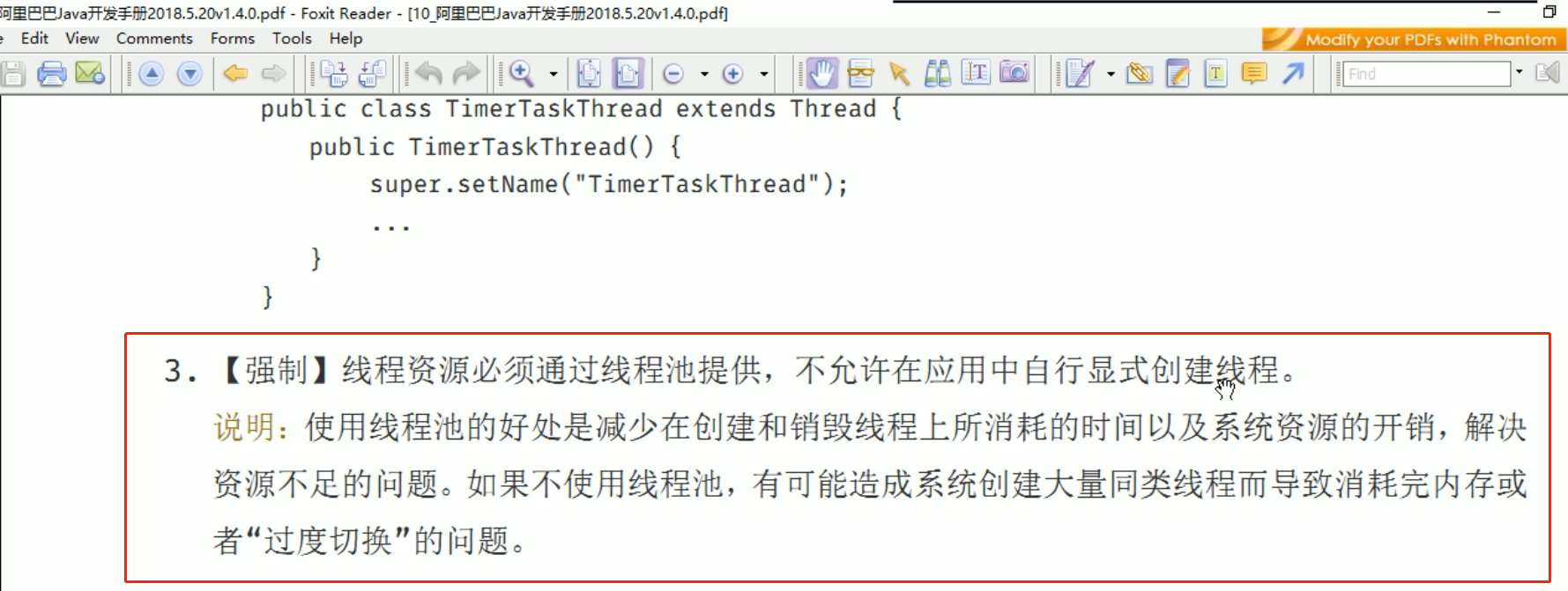

线程池的手写改造和拒绝策略
5个用户办理时
package com.threadTest;
import java.util.concurrent.ExecutorService;
import java.util.concurrent.Executors;
import java.util.concurrent.LinkedBlockingQueue;
import java.util.concurrent.ThreadPoolExecutor;
import java.util.concurrent.TimeUnit;
/**
* 线程池
* 第四种获得/使用java多线程的方式, 前三种分别是 继承Thread类,实现Runnable接口,实现callable接口(有返回值有异常)
*
*/
public class MyThreadPoolDemo {
public static void main(String[] args) {
//7个参数 corePoolSize, maximumPoolSize, keepAliveTime, unit, workQueue, threadFactory, handler
ExecutorService threadPool = new ThreadPoolExecutor(
2,
5,
1L,
TimeUnit.SECONDS,
new LinkedBlockingQueue<Runnable>(3),
Executors.defaultThreadFactory(),
new ThreadPoolExecutor.AbortPolicy());
//模拟10个用户来办理业务,每个用户就是一个来自外部的请求线程
try {
for (int i = 1; i <= 5; i++) {
threadPool.execute(() -> {
System.out.println(Thread.currentThread().getName()+"t 办理业务");
});
//暂停200毫秒
try {TimeUnit.MILLISECONDS.sleep(200);}catch(InterruptedException e) {e.printStackTrace();}
}
} catch (Exception e) {
e.printStackTrace();
}finally {
threadPool.shutdown();
}
}
}

9个用户办理时呢?
package com.threadTest;
import java.util.concurrent.ExecutorService;
import java.util.concurrent.Executors;
import java.util.concurrent.LinkedBlockingQueue;
import java.util.concurrent.ThreadPoolExecutor;
import java.util.concurrent.TimeUnit;
/**
* 线程池
* 第四种获得/使用java多线程的方式, 前三种分别是 继承Thread类,实现Runnable接口,实现callable接口(有返回值有异常)
*
*/
public class MyThreadPoolDemo {
public static void main(String[] args) {
//7个参数 corePoolSize, maximumPoolSize, keepAliveTime, unit, workQueue, threadFactory, handler
ExecutorService threadPool = new ThreadPoolExecutor(
2,
5,
1L,
TimeUnit.SECONDS,
new LinkedBlockingQueue<Runnable>(3),
Executors.defaultThreadFactory(),
new ThreadPoolExecutor.AbortPolicy());
//模拟10个用户来办理业务,每个用户就是一个来自外部的请求线程
try {
for (int i = 1; i <= 9; i++) {
threadPool.execute(() -> {
System.out.println(Thread.currentThread().getName()+"t 办理业务");
});
//暂停200毫秒
try {TimeUnit.MILLISECONDS.sleep(200);}catch(InterruptedException e) {e.printStackTrace();}
}
} catch (Exception e) {
e.printStackTrace();
}finally {
threadPool.shutdown();
}
}
}
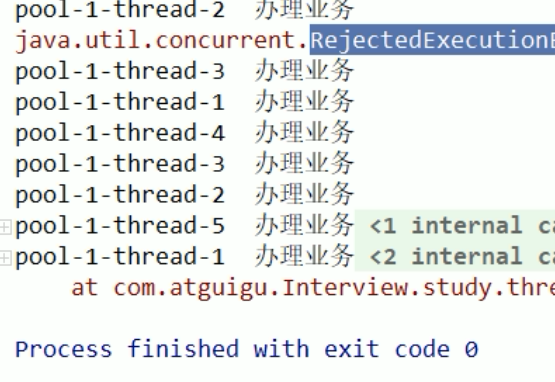
拒绝策略改为new ThreadPoolExecutor.CallerRunsPolicy()
package com.threadTest;
import java.util.concurrent.ExecutorService;
import java.util.concurrent.Executors;
import java.util.concurrent.LinkedBlockingQueue;
import java.util.concurrent.ThreadPoolExecutor;
import java.util.concurrent.TimeUnit;
/**
* 线程池
* 第四种获得/使用java多线程的方式, 前三种分别是 继承Thread类,实现Runnable接口,实现callable接口(有返回值有异常)
*
*/
public class MyThreadPoolDemo {
public static void main(String[] args) {
//7个参数 corePoolSize, maximumPoolSize, keepAliveTime, unit, workQueue, threadFactory, handler
ExecutorService threadPool = new ThreadPoolExecutor(
2,
5,
1L,
TimeUnit.SECONDS,
new LinkedBlockingQueue<Runnable>(3),
Executors.defaultThreadFactory(),
new ThreadPoolExecutor.CallerRunsPolicy());
//模拟10个用户来办理业务,每个用户就是一个来自外部的请求线程
try {
for (int i = 1; i <= 9; i++) {
threadPool.execute(() -> {
System.out.println(Thread.currentThread().getName()+"t 办理业务");
});
//暂停200毫秒
try {TimeUnit.MILLISECONDS.sleep(200);}catch(InterruptedException e) {e.printStackTrace();}
}
} catch (Exception e) {
e.printStackTrace();
}finally {
threadPool.shutdown();
}
}
}
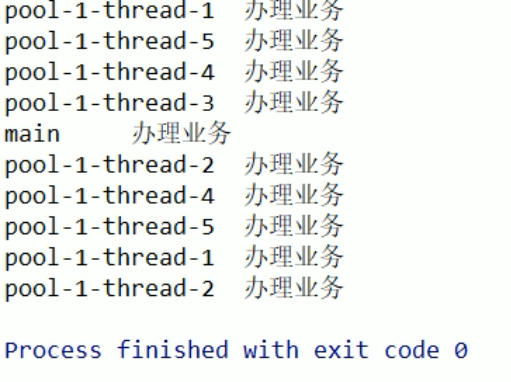
改为new ThreadPoolExecutor.DiscardOldestPolicy()呢?
package com.threadTest;
import java.util.concurrent.ExecutorService;
import java.util.concurrent.Executors;
import java.util.concurrent.LinkedBlockingQueue;
import java.util.concurrent.ThreadPoolExecutor;
import java.util.concurrent.TimeUnit;
/**
* 线程池
* 第四种获得/使用java多线程的方式, 前三种分别是 继承Thread类,实现Runnable接口,实现callable接口(有返回值有异常)
*
*/
public class MyThreadPoolDemo {
public static void main(String[] args) {
//7个参数 corePoolSize, maximumPoolSize, keepAliveTime, unit, workQueue, threadFactory, handler
ExecutorService threadPool = new ThreadPoolExecutor(
2,
5,
1L,
TimeUnit.SECONDS,
new LinkedBlockingQueue<Runnable>(3),
Executors.defaultThreadFactory(),
new ThreadPoolExecutor.DiscardOldestPolicy());
//模拟10个用户来办理业务,每个用户就是一个来自外部的请求线程
try {
for (int i = 1; i <= 10; i++) {
threadPool.execute(() -> {
System.out.println(Thread.currentThread().getName()+"t 办理业务");
});
//暂停200毫秒
try {TimeUnit.MILLISECONDS.sleep(200);}catch(InterruptedException e) {e.printStackTrace();}
}
} catch (Exception e) {
e.printStackTrace();
}finally {
threadPool.shutdown();
}
}
}
少了两个

线程池配置合理线程数
合理配置线程池要考虑业务是CPU密集型还是IO密集型。
看看硬件CPU是几核的
System.out.println(Runtime.getRuntime().availableProcessors());
CPU密集型
CPU密集型的意思是该任务需要大量的运算,而没有阻塞,CPU一直全速运行。
CPU密集任务只有在真正的多核CPU上才可能得到加速(通过多线程)。
而在单核CPU上,无论你开几个模拟的多线程该任务都不可能得到加速,因为CPU总的运算能力就那些。
CPU密集型任务配置尽可能少的线程数量
一般公式:CPU核数+1个线程的线程池
IO密集型
第一种:
由于IO密集型任务线程并不是一直在执行任务,则应配置尽可能多的线程,如CPU核数*2
第二种:
IO密集型,即该任务需要大量的IO,即大量的阻塞。
在单线程上运行IO密集型的任务会导致浪费大量的CPU运算能力浪费在等待。
所以在IO密集型任务中使用多线程可以大大的加速程序运行,即使在单核CPU上,这种加速主要就是利用了被浪费掉的阻塞时间。
IO密集型,大部分线程都阻塞,故需要多配置线程数:
参考公式:CPU核数/(1-阻塞系数)
阻塞系数在0.8~0.9之间
比如8核CPU: 8/(1-0.9) = 80个线程数
最后
以上就是有魅力未来最近收集整理的关于线程池线程池使用及优势线程池如何使用?线程池7大参数入门简介线程池的底层工作原理线程池的4种拒绝策略理论简介工作中用哪个线程池的手写改造和拒绝策略线程池配置合理线程数的全部内容,更多相关线程池线程池使用及优势线程池如何使用?线程池7大参数入门简介线程池内容请搜索靠谱客的其他文章。


![[转发]线程池的使用场景以及java中ThreadPoolExecutor类的讲解](https://file2.kaopuke.com:8081/files_image/reation/bcimg7.png)





发表评论 取消回复